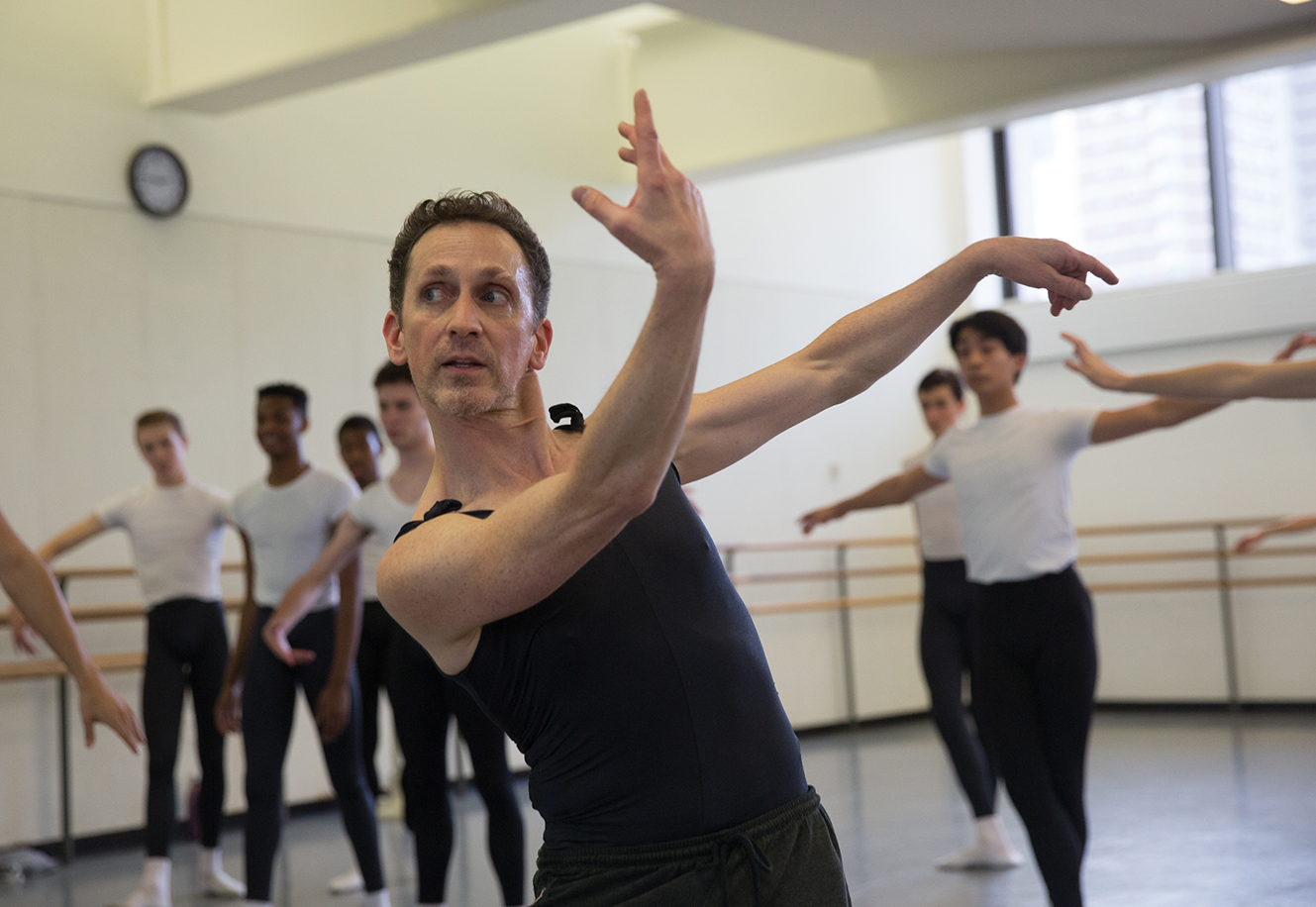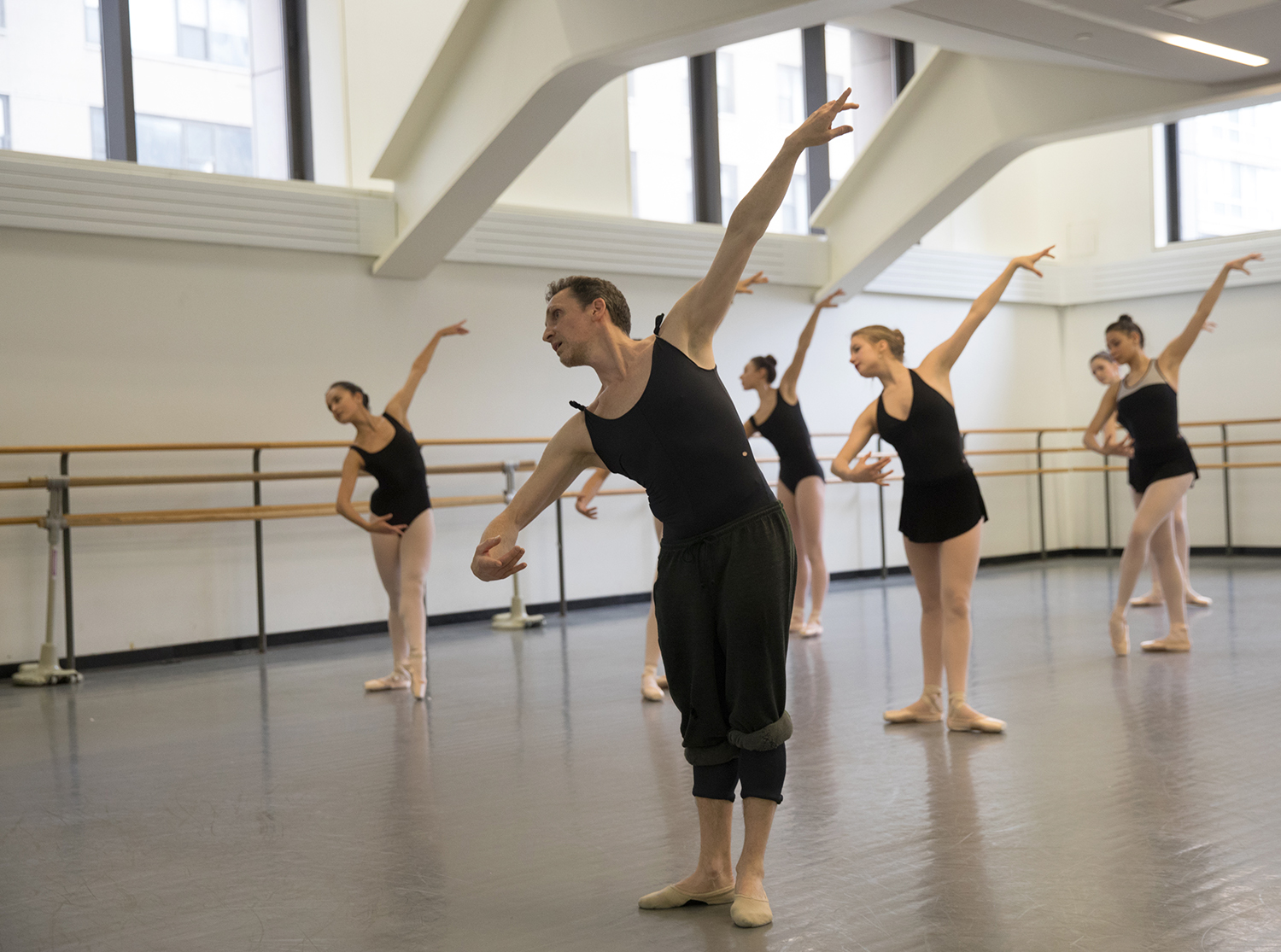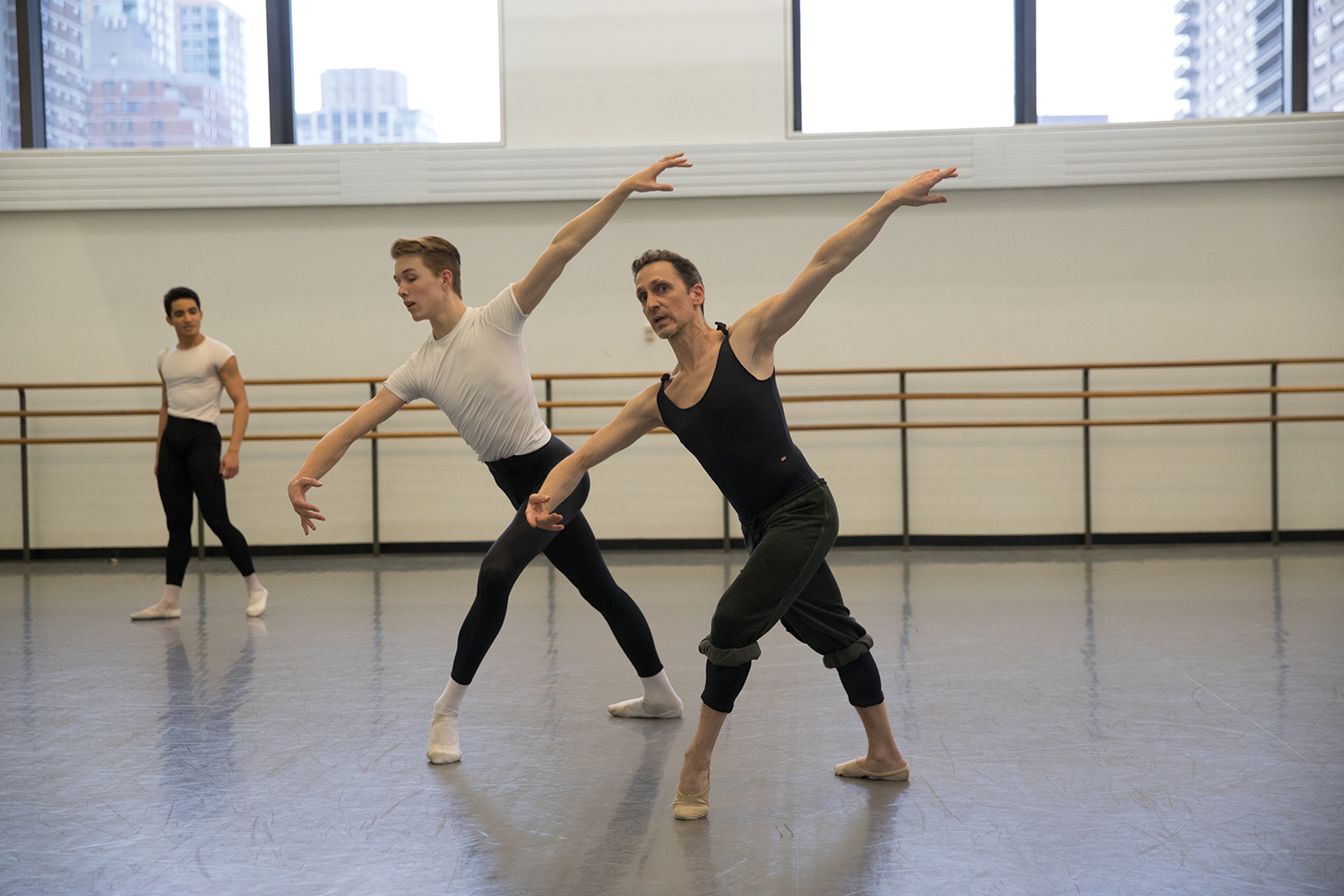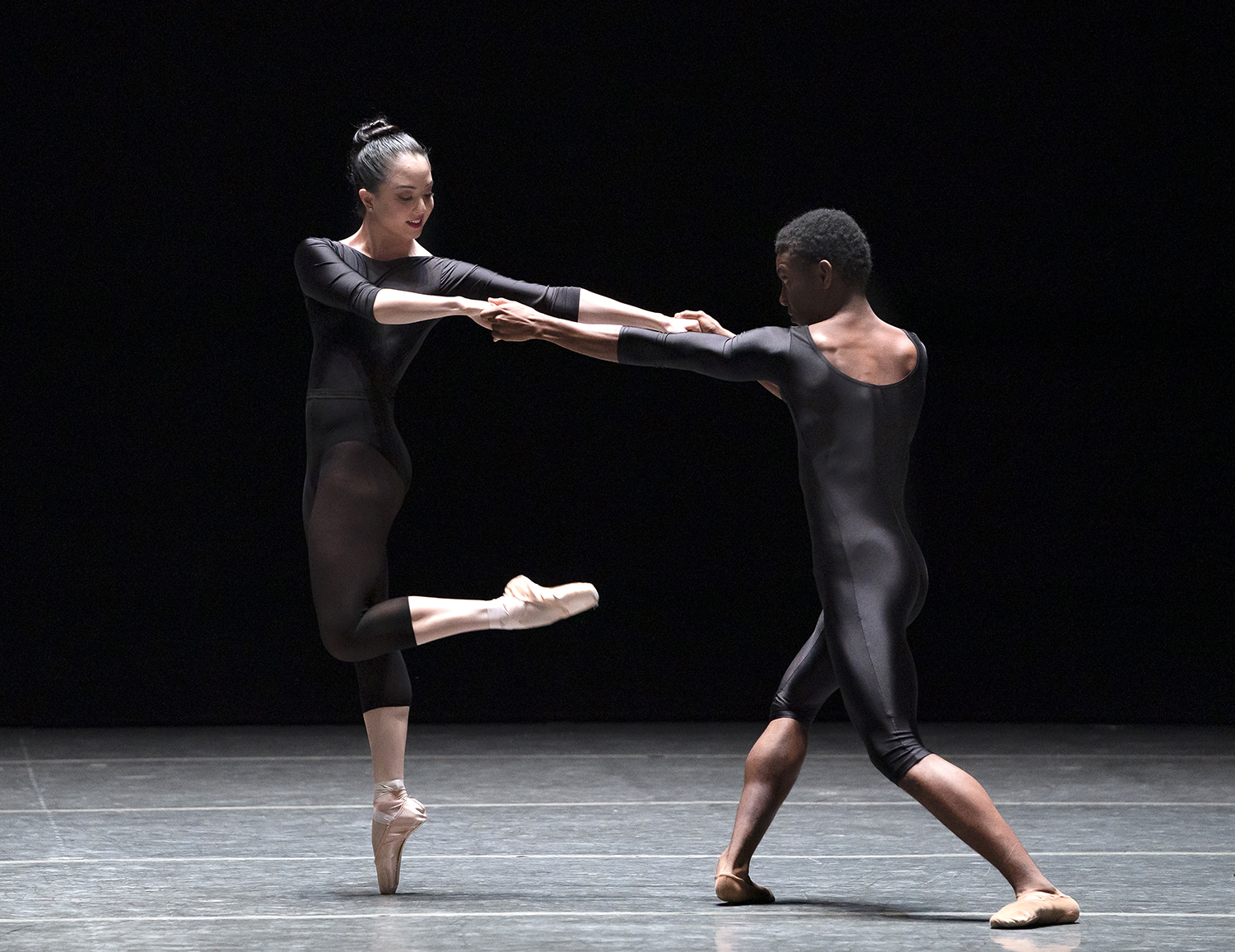June 7, 2022
Celebrating Kay Mazzo – Chairman of Faculty
As Kay Mazzo concludes her tenure as SAB's Chairman of Faculty this week, we wanted to take a moment to acknowledge the tremendous impact her leadership has had on the School.
Last December, SAB’s advanced students joined our virtual zoom classrooms for a unique experience. Instead of practicing a Balanchine or classical variation, students learned an excerpt from William Forsythe’s Limbs Theorem from guest instructor Noah Gelber. An SAB alumnus, Mr. Gelber has made regular visits to the School since 2017 to conduct week-long workshops in contemporary technique and choreography. These sessions are unique from year to year, and students have the opportunity to explore and improvise contemporary movement as well as learn passages from the Forsythe repertoire. This helps broaden our students’ exposure to different styles as they prepare to embark on professional careers with dance companies around the world.

Noah Gelber grew up in New York City and recalls being inspired to pursue dance after seeing his sister perform in a children’s dance recital at the YMCA on West 63rd Street. At five years old, he announced to his family in earnest that he was going to be a dancer! After taking a creative moment class at that same YMCA, Noah was encouraged to audition for SAB in 1977 and went on to train at the School for eleven years. At 16, Noah became a principal guest-artist with American Ballet Company, dancing many prominent Balanchine roles. He also performed in a New York production of West Side Story before leaving America to continue his career in Europe. After three years as soloist with the Royal Ballet of Flanders, he toured the U.S. and Mexico as a principal guest artist before William Forsythe invited him to join the Frankfurt Ballet in 1991. Over the course of a decade, Noah would perform in most of Frankfurt Ballet’s repertoire, earning acclaim for his speed, dynamism and technical precision. Since 1997, while still actively performing with Frankfurt Ballet, Noah taught workshops around the world, flexed his own choreographic muscles and collaborated with a myriad of companies as an expert in Forsythe technique. In addition to being highly skilled in the improvisational techniques of William Forsythe, Noah is also a Choreographic Assistant for twelve Forsythe ballets.
Noah’s return to SAB in 2017 occurred as the School sought to expand our advanced students’ exposure to contemporary ballet choreography and technique. He and fellow Forsythe expert Jodie Gates have both visited regularly to share their expertise, and the success of these guest residencies ultimately led to the inclusion of an excerpt from Forsythe’s New Sleep in SAB’s 2019 Workshop Performances, the first ever public performance by SAB’s students of a Forsythe work.
At the time of his visit to our virtual studios this year, we asked Mr. Gelber to reminisce about his student days, his long performing career and his work at SAB over the past several years. Following are excerpts from our interview.

SAB: What was it like to be a student at SAB? Share any specific memories of your time at the School.
NG: I remember my early years at SAB being a period when there was an explosion of boys attending the school’s Children’s Division. We were told that my first year of Nutcracker was the very first time since its inception, that all of the boy’s roles in the party scene, both A and B casts, had been played by boys. Formerly, there had always been some girls sprinkled in, wearing berets. There were a few magazine articles written about this very subject at the time. A blossoming of young men in dance.
On Mondays because of the theater’s “quiet night,” our boys classes were almost always held in the upstairs studios at the New York State Theater. I would have to say I spent some of the most memorable stretches of my adolescent life inside the corridors of that theater. Those surroundings molded my sensibility, affinity for, and deep connection to music and dance alike.
I remember being made fun of a lot. I mean, a LOT. I was subject to more than my share of bullying. At academic school, just because I was a boy and a dancer; at SAB because I was small. I was scrawny. I didn’t have the fortunate genetic traits of a natural “prince” or model type. One could look at my feet and bone structure and see I was not going to grow to be 6 feet. Year after year, I was told I was too short to ever have a successful career. I remember a lot of insults, dismissive criticism about my physical stature or lack thereof, and ongoing cracking of jokes at my expense. To survive, I had to try to find alternate ways to seek positive attention and the choices of a frightened child are not always the wisest. I might not have been everybody’s favorite, but I was definitely hard to miss. Thankfully, some key staff members saw talent and took time and care to nurture it.
My favorite teacher from the earlier boys class years was Jean-Pierre Bonnefoux. His classes were derivative of the French School and we always learned steps from him which were particular to his lessons. He also chose me at a very young age for two choreographies he made for performances outside of SAB. I felt I could talk to him in a way that was what I imagined it was to be like an adult. I am also much indebted to Richard Rapp’s classes, which were very difficult but really pushed our limits. I am still thankful to him for making us execute whole, four-part petite allegro combinations both right and left, adding beats to nearly everything to which they could be applied, and then reversing the combinations entirely. I have rarely seen this kind of thoroughness again, anywhere.
But it was Stanley Williams who perhaps had the most enduring influence on me, who approached ballet with a level of intelligence and mystery that captured our fascination and set the proverbial bar, the level to which we all aspired to rise. In my final year at SAB, Stanley was teaching us the pas de sept from Bournonville’s A Folktale for Workshop. About halfway through the process, he gave me his personal video from the Royal Danish Ballet to take home. He asked me to learn the whole thing and then assigned me to teach parts of the group scenes for him. I did this with great enthusiasm, probably to the perplexity of my fellow students. One might say, those were the very beginnings of honing my path towards becoming a choreographic assistant and ballet master.
SAB: William Forsythe invited you to the Frankfurt Ballet in 1991. Tell us about what it was/is like to work with him.
NG: What it was like to work with him? My goodness, where to even begin? It was a long process of self-assessment which continues even today. To enter the Frankfurt Ballet was to be confronted with one’s own limitations, one’s preconceived ideas, one’s own taboos. One had to be clear of any and all hinderances or second-guessing in order to act and find inspiration in the spur of any given moment, without hesitation. It was very scary at first–a lot of tears and mini-crises. The first season was tumultuous emotionally. But everyone else in the company had gone through the same initial process so there was a lot of encouragement and moral support. And the creative side of it, my GOD! One could call it divine insanity. Like waking up on Mars. What a diverse, sublime group of talented, brilliant and completely bizarre artists, all bouncing ideas off each other! In my previous company, I had been “the crazy one”. Arriving in Frankfurt Ballet, I felt ordinary, boring, conventional. Being there required one to re-find oneself, and then continue that search perpetually. It was not even close to solely a matter of picking up steps or remembering counts, both of which I was good at. It was about assembling an entire scientific thesis around an approach to movement construction, and discovering what each of us could personally contribute to the process from our unique angle.
To have Bill choreograph something on me directly… just made me so very, fundamentally happy. Inevitably very physically exhausted, but happy indeed. And I’m thrilled to now be in a position to share and disseminate these wonderful choreographies to dancers all over the world.
SAB: How did your early ballet training at SAB in the Balanchine aesthetic help you throughout your career?
NG: I can definitely say that precision and attention to rhythmical versatility was a key skill which pervaded my training and remained a beneficial driving force throughout my career, wherever I went. Whether I was immersed in classical ballet, Graham technique, Flamenco, Jazz or Contemporary styles, Balanchine or Forsythe choreographies, I was always praised for precision, phrasing and musicality.
When I first began working with Bill, I found his jovial, unpredictable quirkiness in the handling of in-to-out, up-to-down, pleasingly familiar and comprehensible. These contrapuntal aspects can be the most challenging for dancers or companies who are more accustomed to purely square, classical influences and less versed in the neoclassical repertoire. Whenever I set Forsythe choreographies on SAB students, I am always impressed with how quickly they grasp these fine rhythmical intricacies.

SAB: What is it like working with our students in a style that’s different than what they are used to?
NG: It is always a combination of challenge and surprise, no matter where I teach. I approach every group with a clean slate, aiming to enter the studio with no preconceptions. And my goal is to adapt my process to the needs of those dancers I have in the room. It’s definitely far, far from a cookie-cutter formula. And thus far at SAB I have yet to repeat any of the choreographic material I have taught. I want each year to feel they have had a genuinely independent experience all their own. My aim when I teach is to remain open to what I am seeing and feeling (and hearing; I encourage dancers to speak up and be truthful about what they need) as the teaching moves along, and I look to address what requires attention.
Each experience is perhaps as new for me as it is for the students with whom I am engaging. I feel I am always learning new skills. My position as “guide,” and let’s say “overseer,” of the workshops I teach, is to find solutions. To conjure up imagery which will aid dancers or students encountering challenging moment, to surmount the task at hand. It keeps me examining my words, ever evolving my descriptive ingenuity. What works for one group usually doesn’t work for another. And this is even more so the case, from dancer to dancer. So I may correct individuals in the same room, from a fundamentally different vantage point about their approaches to the same movement.
SAB: In 2019, you staged New Sleep on students for SAB’s annual Workshop. What was it like working with our students to present the first Forsythe work at Workshop?
I was staging New Sleep pas at the same time I was staging Herman Schmerman (both the pas de cinq and pas de deux) on NYCB. I would work at State Theater (forgive me, my age will always lead me to refer to it by that name) from after company class until early evening, then I’d walk across that spiffy new bridge spanning 65th street directly to the Rose building to continue with the SAB students from 7:00 to 9:00 PM. I admired them for accommodating those late hours, for remaining focused and pulling through what must have been the last hour of fatigue from the day’s other activities. It was also a stretch on my brain, keeping 3 different ballets actively available to be pulled out when needed. There were moments I felt like I had multiple personalities. But the students were wonderful, patient with me when I had moments where my memory came up blank and needed a refresher. I really prefer to work without videos when I teach so the dancers can embody and create their own feeling and delivery rather than merely imitating what they think they see someone else having done. But I admit, while staging New Sleep I needed to sneak a quick look at the video now and then just to reconfirm if something began with the right or left leg. There’s only so much precision my brain can manage at a time.
Let’s be honest, New Sleep pas is not easy. Not only is it very fast, it is technical from beginning to end and it is long. Once the dancing begins there are few moments to catch a breath all the way through. And it was choreographed for a very accomplished, mature, musical Russian ballerina, so it has a lot of sophisticated European flair. A nice juicy challenge for 16-18 year old students to bite into! The score has an unrelenting drive and multiple layers of very unusual sounds, syncopated rhythms. Also a stretch for many a student. But I was quite happy sharing the collaborative process with these young couples in the studio. Sadly my summer work schedule had me far away from New York at the time of the actual performances, but I was able to see videos after the fact.

SAB: Tell us about conducting this year’s SAB classes online over Zoom.
The zoom classes with the students were like a lifeline. My SAB teaching dates were agreed upon a whole year earlier, as soon as I had completed my 2019 classes. We have learned to reserve dates so early because my travel schedule can usually get so densely busy. And then 2020 changed all that. So much work evaporated. And yet, those agreed dates for classes at SAB remained constant like a positively-lit buoy in the distance. I thank Jon (Stafford), Kay (Mazzo) and Allen (Peiffer) for being tenacious and making it all come to fruition.
I feel so privileged to have had access to SAB’s Rose Building studios for my zoom classes, even if I ended up being in there all alone. Prior to those classes in December, I had experienced a long period all but devoid of interaction or artistic work. Back in mid-March 2020, my job at the Vienna State Opera was ended prematurely as COVID-19 flared and I was flown out of Austria into Germany just hours before the borders were sealed. I spent my first two months of the big lockdown in isolation outside Berlin, with almost no internet connection at all. I could hardly have imagined at that time that so much could be accomplished virtually. Once I returned to the US to be with my father, I only taught a few zoom classes in July using my family’s garage in rural Maine. But there’s simply nothing like being back in a real dance space–even if for those teaching purposes one finds oneself entirely alone.
Seeing the students in their respective surroundings, remaining so dedicated to their art, was heart-warming and felt almost heroic. Some were on outdoor back decks, others in bedrooms, garages and attics. I saw house entryways, kitchen counters, living room sofas. And all that determination which united us all. I respect the students’ resolve and perseverance, which gives me faith that dance is indeed alive under what one sees on the current surface. I applaud them and I hope they understand how much my heart is with them in these crazy times.
June 7, 2022
As Kay Mazzo concludes her tenure as SAB's Chairman of Faculty this week, we wanted to take a moment to acknowledge the tremendous impact her leadership has had on the School.
October 5, 2021
In honor of World Teachers' Day, we wanted to send out a very special thanks to all our talented faculty members at SAB.
January 5, 2021
Agon is a beloved Balanchine ballet that is both thrilling and inspiring to watch, but what's it like to perform this technically challenging ballet?